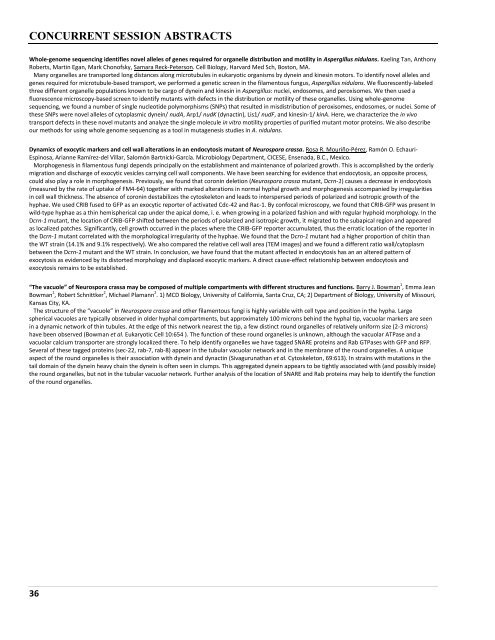Program Book - 27th Fungal Genetics Conference
Program Book - 27th Fungal Genetics Conference
Program Book - 27th Fungal Genetics Conference
You also want an ePaper? Increase the reach of your titles
YUMPU automatically turns print PDFs into web optimized ePapers that Google loves.
CONCURRENT SESSION ABSTRACTSWhole-genome sequencing identifies novel alleles of genes required for organelle distribution and motility in Aspergillus nidulans. Kaeling Tan, AnthonyRoberts, Martin Egan, Mark Chonofsky, Samara Reck-Peterson. Cell Biology, Harvard Med Sch, Boston, MA.Many organelles are transported long distances along microtubules in eukaryotic organisms by dynein and kinesin motors. To identify novel alleles andgenes required for microtubule-based transport, we performed a genetic screen in the filamentous fungus, Aspergillus nidulans. We fluorescently-labeledthree different organelle populations known to be cargo of dynein and kinesin in Aspergillus: nuclei, endosomes, and peroxisomes. We then used afluorescence microscopy-based screen to identify mutants with defects in the distribution or motility of these organelles. Using whole-genomesequencing, we found a number of single nucleotide polymorphisms (SNPs) that resulted in misdistribution of peroxisomes, endosomes, or nuclei. Some ofthese SNPs were novel alleles of cytoplasmic dynein/ nudA, Arp1/ nudK (dynactin), Lis1/ nudF, and kinesin-1/ kinA. Here, we characterize the in vivotransport defects in these novel mutants and analyze the single molecule in vitro motility properties of purified mutant motor proteins. We also describeour methods for using whole genome sequencing as a tool in mutagenesis studies in A. nidulans.Dynamics of exocytic markers and cell wall alterations in an endocytosis mutant of Neurospora crassa. Rosa R. Mouriño-Pérez, Ramón O. Echauri-Espinosa, Arianne Ramírez-del Villar, Salomón Bartnicki-García. Microbiology Department, CICESE, Ensenada, B.C., Mexico.Morphogenesis in filamentous fungi depends principally on the establishment and maintenance of polarized growth. This is accomplished by the orderlymigration and discharge of exocytic vesicles carrying cell wall components. We have been searching for evidence that endocytosis, an opposite process,could also play a role in morphogenesis. Previously, we found that coronin deletion (Neurospora crassa mutant, Dcrn-1) causes a decrease in endocytosis(measured by the rate of uptake of FM4-64) together with marked alterations in normal hyphal growth and morphogenesis accompanied by irregularitiesin cell wall thickness. The absence of coronin destabilizes the cytoskeleton and leads to interspersed periods of polarized and isotropic growth of thehyphae. We used CRIB fused to GFP as an exocytic reporter of activated Cdc-42 and Rac-1. By confocal microscopy, we found that CRIB-GFP was present Inwild-type hyphae as a thin hemispherical cap under the apical dome, i. e. when growing in a polarized fashion and with regular hyphoid morphology. In theDcrn-1 mutant, the location of CRIB-GFP shifted between the periods of polarized and isotropic growth, it migrated to the subapical region and appearedas localized patches. Significantly, cell growth occurred in the places where the CRIB-GFP reporter accumulated, thus the erratic location of the reporter inthe Dcrn-1 mutant correlated with the morphological irregularity of the hyphae. We found that the Dcrn-1 mutant had a higher proportion of chitin thanthe WT strain (14.1% and 9.1% respectively). We also compared the relative cell wall area (TEM images) and we found a different ratio wall/cytoplasmbetween the Dcrn-1 mutant and the WT strain. In conclusion, we have found that the mutant affected in endocytosis has an an altered pattern ofexocytosis as evidenced by its distorted morphology and displaced exocytic markers. A direct cause-effect relationship between endocytosis andexocytosis remains to be established.“The vacuole” of Neurospora crassa may be composed of multiple compartments with different structures and functions. Barry J. Bowman 1 , Emma JeanBowman 1 , Robert Schnittker 2 , Michael Plamann 2 . 1) MCD Biology, University of California, Santa Cruz, CA; 2) Department of Biology, University of Missouri,Kansas City, KA.The structure of the “vacuole” in Neurospora crassa and other filamentous fungi is highly variable with cell type and position in the hypha. Largespherical vacuoles are typically observed in older hyphal compartments, but approximately 100 microns behind the hyphal tip, vacuolar markers are seenin a dynamic network of thin tubules. At the edge of this network nearest the tip, a few distinct round organelles of relatively uniform size (2-3 microns)have been observed (Bowman et al. Eukaryotic Cell 10:654 ). The function of these round organelles is unknown, although the vacuolar ATPase and avacuolar calcium transporter are strongly localized there. To help identify organelles we have tagged SNARE proteins and Rab GTPases with GFP and RFP.Several of these tagged proteins (sec-22, rab-7, rab-8) appear in the tubular vacuolar network and in the membrane of the round organelles. A uniqueaspect of the round organelles is their association with dynein and dynactin (Sivagurunathan et al. Cytoskeleton, 69:613). In strains with mutations in thetail domain of the dynein heavy chain the dynein is often seen in clumps. This aggregated dynein appears to be tightly associated with (and possibly inside)the round organelles, but not in the tubular vacuolar network. Further analysis of the location of SNARE and Rab proteins may help to identify the functionof the round organelles.36











